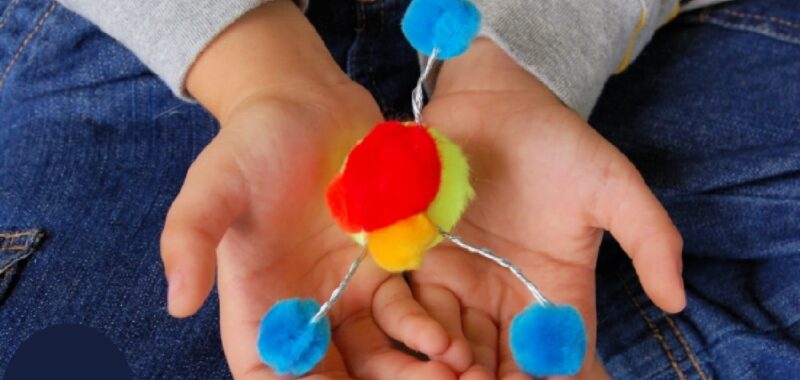Introducing children to the fascinating world of atoms and molecules can spark a lifelong interest in science. These building blocks of matter make up everything around us, yet they remain invisible to the naked eye. Sounds kinda magical?! These hands-on, interactive and downright fun experience that encourages curiosity and critical thinking. Use these fun science activities in the home or classroom.

Learning About Atoms & Molecules
Let’s explore engaging science and STEM activities designed to help kids grasp the concepts of atoms and molecules through play and practical experiments.
Related: Scientific method for kids <–grab the free worksheet
We decided to do this today because my kids were learning about molecules in school and it reminded me of the experiment that we did here at Kids Activities Blog awhile back, creating model atoms for kids to physically manipulate. We “made” atoms too!
The terms “atom” and “molecule” are fundamental to chemistry, but they refer to different entities…
What is an Atom?
- An atom is the smallest unit of an element that retains the properties of that element. It consists of a nucleus (made up of protons and neutrons) and electrons that orbit the nucleus. Atoms are incredibly small and are the basic building blocks of all matter.
- Atoms can exist independently or can combine with other atoms to form more complex structures.
What is a Molecule?
- A molecule is a group of two or more atoms that are chemically bonded together, sharing electrons through chemical bonds. Molecules can be made up of atoms from the same element (like O?, which is an oxygen molecule) or from different elements (like H?O, water, which includes two hydrogen atoms and one oxygen atom).
- Molecules are the smallest unit of a compound that can exist independently while retaining all of the chemical properties of that compound.
Make a Molecule Model
Supplies Needed to Make a Molecule
- Pom-poms – a variety of colors and sizes
- Wire
- Glue
Directions to Make a Molecule
Step 1
Our kids researched the elements and created the atoms of nitrogen and carbon and a molecule of propane. The concepts of a atom’s nucleus and the relationship of the different atoms makes more sense when they are able to touch and feel them!
Wait, are Nitrogen and carbon Atoms or Molecules?
Nitrogen and carbon, when referred to individually as elements, are atoms, not molecules:
- Carbon (C): An atom of carbon represents the basic unit of the element carbon. It is not a molecule unless it bonds with other carbon atoms or different elements. The atomic number of carbon is 6. This number represents the number of protons found in the nucleus of a carbon atom, and it also determines the element’s position on the periodic table.
- Nitrogen (N): Similarly, a nitrogen atom is the basic unit of the element nitrogen. It becomes part of a molecule when it forms bonds with other atoms. For example, the nitrogen molecule (N?), which makes up about 78% of the Earth’s atmosphere, consists of two nitrogen atoms bonded together. The atomic number of nitrogen is 7. This number indicates that a nitrogen atom contains seven protons in its nucleus.
So, in their basic elemental forms, both nitrogen and carbon are atoms. When they bond with themselves or with other atoms, they form molecules.

Creating a Propane Molecule
Propane, a hydrocarbon that is commonly used as a fuel, has the chemical formula C3?H8?. This formula indicates the composition of propane in terms of its constituent atoms:
- Carbon (C): Propane contains three carbon atoms.
- Hydrogen (H): Propane contains eight hydrogen atoms.
These atoms are arranged in a chain, with the three carbon atoms connected linearly to each other, and the hydrogen atoms filling the remaining bonds to complete the tetrahedral geometry around each carbon. This structure gives propane its chemical and physical properties, making it useful as a compact and transportable fuel source.
Step 2
Assign colors or sizes of pom poms to represent protons, neutrons and electrons and then build your atom and molecules with wire and glue. You can see how you can combine them together for larger and more complex molecule learning.
More activities and experiments to learn about Molecules

Building atoms and molecules is so much fun! Here are several ways you can get hands on with these building blocks with your kids:
- Explore if Molecules move with a couple sheets of wax paper and this simple experiment.
- Do molecules disperse more easily when water is frozen, room temperature or solid ice? This is a simple experiment that your kids will remember.
- Try mixing molecules “ watch how the surface tension of oil repels water. No matter how hard your kids try they won’t be able to mix them.
- See how molecules “ like molecules of water “ are attracted to each other. Witness the pull of the electron shell with this experiment.
- Create Edible Atoms
- Make a 3-D molecule with marshmallows and sugar drops
- Re-create the molecular field with a pizza box.
- Check out this atom model how-to!
Do you want to learn more? This is the best book to discuss the different elements that are known in the world.
More Science Fun from Kids Activities Blog
What science activity did you do to learn about atoms and molecules?

